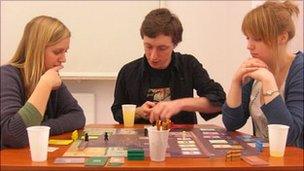Polish game recreates communist shopping hell
- Published

The game is meant to teach the post-communist generation what everyday shortages were like
Poles have been queuing to buy a new board game called "Kolejka" (The Queue), which recreates the tedious shopping experience of communist-era Poland.
Crowds of people, including those who remember standing for days in queues and teenagers who were not even born in the 1980s, lined up at the state-run Institute of National Remembrance (IPN) to buy the game.
"I'm too young to remember, I'm just trying to find a way to explore this period of time. I'm interested in the history of the country and my parent's history," said Anna Moronczyk, as she queued with her 17-month-old son to get a copy.
The IPN is the home of Poland's communist-era archives and investigates crimes from that period. It also promotes awareness of that time and devised the game as an educational tool, to teach young Poles about history in an entertaining way. Half of the first batch is being reserved for schools.
"We hope it will show young Poles how difficult it was to buy everyday supplies like sugar, bread or furniture," said Karol Madaj, the game's designer. He was only nine years old when communism ended in Poland in 1989, so he had to seek tips about those days from his older boss.
"Some young Poles don't believe there were queues in those days. You can see it written on the internet forums. They think queues only started when department stores began the sales," he added.
To prove queues did exist, minutes earlier Karol screened black-and-white documentary footage of people lining up in butchers' shops in the hope of getting a cut of meat.
Grim shopping lottery

Players can queue-jump with cards giving them special advantages
A Polish education ministry spokesman, Grzegorz Zurawski, acknowledges that currently there is too little focus on recent history in schools. Only the last few weeks of a student's final year is devoted to it.
"We are changing our way of teaching modern history because we know now that many young Poles know nothing about this period," he said. The ministry plans to introduce a new curriculum in 2012 which reflects greater emphasis on 20th-Century history.
The game comes in a box designed to look like it was wrapped in brown paper and tied with string. On top is a coupon, which the communist authorities issued so they could ration items like meat.
Between two and five players compete to be the first to buy the 10 items on their shopping list. Players send out family members, represented by coloured wooden figures, to line up outside different shops for the authentic 1980s products, such as a tape recorder with two spools of tape, tinned ham or "Popularna" tea, which promised "heaven in your mouth".
The problem is that the shelves in the neighbourhood shops are empty and players must queue without knowing which store will soon get a delivery.
Once a delivery arrives, there is only enough stock for people at the front of the queue to make a purchase. Special cards help players to queue-jump, such as one showing a mother carrying a baby or another which gives insider delivery information from a friend in the local Party apparatus.
There is also a black market, where everything is twice the normal price.
'Exactly like this'

The game's functional box also mimics no-frills communist shopping
Some of those who had queued to buy the game and could not wait to get home to play it sat down at specially-prepared tables in the IPN building to test it out.
"It was exactly like this," Piotr Zochowski, 44, told me as he played the game with his wife and three children.
"Then you had to queue for everything. I remember when I bought shoes with coupons. The only ones I could buy were about half a size too small - but there were no others, so I had to buy them," he said.
At the next table, students Ania, Lukasz and Maria, who were happy to describe themselves as "board game geeks", said it surpassed their expectations.
"It's well-designed, it looks nice, it could be a commercially-produced game," Lukasz said. Of the three, only Lukasz had been born when communism ended in Poland in 1989, but they all remembered the products from those days.
"I had this cassette player," Ania said. "And I had that lamp," Maria said, pointing to an orange metal table lamp with a flexible stand. "Everybody had that lamp," she added.